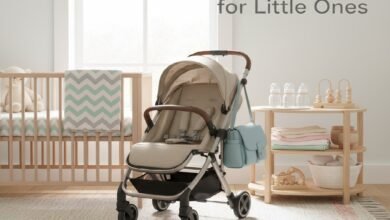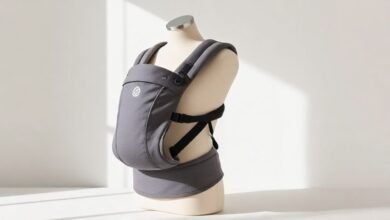Smart Baby Monitors & Wearables: Peace of Mind in 2025
Being a parent often means balancing love with worry—especially overnight. Smart baby monitors and wearable monitors promise to give parents more insight into their baby’s well-being, whether you want to check breathing, movement, sleep quality, or temperature. But how reliable are they? What features matter today? Let’s review, compare, and see what to look for in 2025.
🌟 What Are Smart Baby Monitors & Wearables?
Smart baby monitors are devices that go beyond simple video and audio: they may include sensors for breathing, movement, temperature, or position. Wearables are devices the baby actually wears (sock, clip, button, band) or that attach, to track vital signs and alert parents. These tools connect to apps, base-units, or cloud systems, often via WiFi or Bluetooth.
🔍 Key Features to Look for in 2025
- Accuracy & Sensor Reliability: Movement sensors, breathing detection, oxygen levels—how precise and fast are the alerts?
- Safety & Privacy: Encryption of data, secure WiFi, firmware updates. Risks of hacking or data breaches are real. Reuters+2New York Post+2
- Comfort & Wearability: If it’s a wearable, does it irritate skin? Is it suitable for newborns? Is it safe (non-toxic materials, no choking hazards)?
- App & Notification Quality: Are alerts timely? Are there too many false alarms? Is the user interface easy for sleep-deprived parents?
- Power Life & Connectivity: Battery life, range (base unit ↔ wearable), WiFi vs Bluetooth, whether device works without internet (important during outages).
⚖️ Comparing Smart Monitors vs Wearables
| Type | Pros | Cons |
|---|---|---|
| Video/Audio Smart Monitors (with motion detection, temperature sensors, camera & night vision) | Provides visual reassurance; you see what’s happening, not just data. Useful for shared spaces, babysitters, etc. | Higher cost; depend on stable internet; privacy risks; sometimes lag or video freezes. |
| Wearable Monitors (smart socks, clips, buttons) | Continuous monitoring of vitals; alerts for breathing/movement; portable; often less visible/hands-free. | Potential discomfort; skin sensitivity; sometimes inaccurate; false alerts; may increase anxiety. |
🔧 What Research & Reviews Say
- Devices like Sense-U Baby v3 are rated for movement monitoring and position alerts; review sites highlight ease of use but note limitations in alert types and occasional connectivity issues. Baby Gear Lab
- Experts warn parents: false alarms are a big problem, and many wearable devices are not approved medical devices. The reliability of vital signs monitoring (like oxygen saturation) is often less than parents expect. Wareable+2New York Magazine+2
- Devices like the Summer Infant Babble Band offer wearable audio monitors (wristbands) for hearing baby’s sounds, which many parents like, though battery life and signal range can be limitations. Mother & Baby
📈 Trends in Smart Baby Monitoring in 2025
- Increased focus on privacy & cybersecurity: new labeling initiatives (like Cyber Trust Mark) to help consumers pick secure devices. Reuters
- Hybrid models: combining video monitors with wearables (video + vital sensors) so parents get both visuals and physiological data.
- Non-invasive sensors: more devices that work via contact-light or clip-on rather than large wearable bands or socks.
- Smart alerts & AI: sleep tracking, trend predictions (when baby wakes often), intelligent suggestions (room temp too cold/hot).
- Offline and backup modes: devices working without WiFi, retaining data locally, or notifying safety in conditions of network loss.
🛒 Product Spotlight: What’s Good Out There
Here are some examples that align with current trends and buy-worthiness:
- Sense-U Baby v3: A movement monitoring wearable button that tracks breathing cues, gives position alerts, pairs with smartphones. Good ease of use, though pricier. Baby Gear Lab
- Summer Infant Babble Band: A wristband-style audio wearable to detect sound and vibrate; simple, discreet, though battery life (≈8 hours in tests) limits overnight use. Mother & Baby
- Smart video monitors with wearables (Owlet + Cam, etc.): These allow monitoring via video + wearable sock or clip; you get extra data (movement, oxygen, etc.) but must accept cost and potential for false alerts. Engadget+2New York Magazine+2
⚠️ Cautions & What Parents Should Know
- Even with newest tech, false alerts are common. These can lead to stress, sleep disruption, or unnecessary calls to healthcare.
- Not a substitute for safe sleep practices: place babies on their back, firm mattress, no loose bedding. Wearables or smart monitors don’t replace these rules.
- WARRANTY, SUPPORT & UPDATES are important. A device that isn’t updated is more vulnerable.
- Always read instruction manuals for correct usage, placement, sensitivity settings.
💌 Subscription Pick: Infant Monitoring Service
To get more value, some brands or platforms offer subscription services:
- Sleep-tracking premium app plans: advanced analytics over time, trends (sleep duration, wake ups), parenting insights.
- Camera cloud storage: video monitors often offer monthly/yearly subscriptions for video history, alerts, backups.
- Support & Warranty Upsell: extended warranty or replacement parts as service.
For example, if you get a video monitor with cloud storage, the monthly subscription ensures you can review what happened overnight, check alerts, and keep backups.
✅ Final Verdict
Smart baby monitors and wearables in 2025 offer powerful tools for parents wanting more info and reassurance—but they come with trade-offs.
- If you prefer seeing what’s happening (visuals) and are okay with paying more, a video monitor plus enrolled features makes sense.
- If you’re more data-oriented (sleep, breathing/movement), a reliable wearable may help—but pick one with great reviews on accuracy and low false alarm rates.
- Always make privacy and safety part of your decision: the best device is one you trust, one that keeps data secure, one that works even when your WiFi is weak, and one that doesn’t end up causing more anxiety than useful reassurance.



